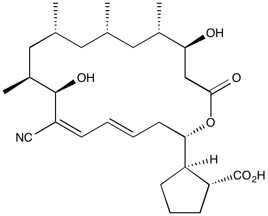Borrelidin | Angiogenesis inhibitor
NMR (Conforms)

Available Options
| size : | Price | Quantity | |
|---|---|---|---|
| 1 mg | $190.00 | ||
| 5 mg | $760.00 |
Borrelidin (7184-60-3) ia a novel macrolide which inhibits bacterial and eukaryotic threonyl-tRNA synthetase.1 Displays potent anti-angiogenic activity (IC50=0.8 nM) and induces the collapse of newly formed capillary tubules.2 Modulates alternative splicing of VEGF in favor of anti-angiogenic isoforms.3 Induces apoptosis in ALL cell lines.4 Induces unfolded protein response in oral cancer cells.5 Cell permeable.
References/Citations
1) Ruan et al. (2005), A unique hydrophobic cluster near the active site contributes to differences in borrelidin inhibition among threonyl-tRNA synthetases; J. Biol. Chem., 280 571
2) Kawamura et al. (2003), Anti-angiogenesis effects of borrelidin are mediated through distinct pathways: threonyl-tRNA synthase and caspases are independently involved in suppression of proliferation and induction of apoptosis in endothelial cells; J. Antibiot., 56 709
3) Woolard et al. (2011) Borrelidin modulates the alternative splicing of VEGF in favour of anti-angiogenic isoforms; Chem. Soc. 2011 273
4) Habibi et al. (2012), Borrelidin, a small molecule nitrile-containing macrolide inhibitor of threonyl-tRNA synthase, is a potent inducer of apoptosis in acute lymphoblastic leukemia; Invest. New Drugs, 30 1361
5) Sidhu et al. (2015), Borrelidin Induces the Unfolded Protein Response in Oral Cancer Cells and Chop-Dependent Apoptosis; ACS Med. Chem. Lett., 6 1122
NMR (Conforms)
Safety Data Sheet:
Product Data Sheet:
Materials provided by Focus Biomolecules are for laboratory research use only and are not intended for human or veterinary applications. Please note that we do not sell to individuals and that all orders placed by non-research organizations will incur a $20 restocking/refund fee
Borrelidin (7184-60-3) ia a novel macrolide which inhibits bacterial and eukaryotic threonyl-tRNA synthetase.1 Displays potent anti-angiogenic activity (IC50=0.8 nM) and induces the collapse of newly formed capillary tubules.2 Modulates alternative splicing of VEGF in favor of anti-angiogenic isoforms.3 Induces apoptosis in ALL cell lines.4 Induces unfolded protein response in oral cancer cells.5 Cell permeable.
References/Citations
1) Ruan et al. (2005), A unique hydrophobic cluster near the active site contributes to differences in borrelidin inhibition among threonyl-tRNA synthetases; J. Biol. Chem., 280 571
2) Kawamura et al. (2003), Anti-angiogenesis effects of borrelidin are mediated through distinct pathways: threonyl-tRNA synthase and caspases are independently involved in suppression of proliferation and induction of apoptosis in endothelial cells; J. Antibiot., 56 709
3) Woolard et al. (2011) Borrelidin modulates the alternative splicing of VEGF in favour of anti-angiogenic isoforms; Chem. Soc. 2011 273
4) Habibi et al. (2012), Borrelidin, a small molecule nitrile-containing macrolide inhibitor of threonyl-tRNA synthase, is a potent inducer of apoptosis in acute lymphoblastic leukemia; Invest. New Drugs, 30 1361
5) Sidhu et al. (2015), Borrelidin Induces the Unfolded Protein Response in Oral Cancer Cells and Chop-Dependent Apoptosis; ACS Med. Chem. Lett., 6 1122
Related ER Stress Products
Download
Calculate the molar concentration, mass or volume in a solution.
Concentration × Volume × Molecular Weight = Mass
Focus Biomolecules • Plymouth Meeting, PA USA • 1-855-FOCUS21
Focus Biomolecules
Plymouth Meeting, PA USA
1-855-FOCUS21
Website Created by Advanta Advertising LLC.

